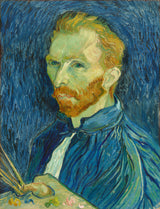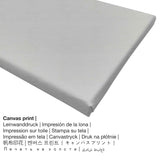Vincent van Gogh, 1889 - Self-Portrait - fine art print
Tax included. Shipping calculated at checkout.
Detailed product infos
This more than 130 year-old piece of art Self-Portrait was painted by the Dutch artist Vincent van Gogh in 1889. The version of the masterpiece was painted with the following size of 57,79 × 44,5 cm (22 3/4 × 17 1/2 in) and was painted with the technique of oil on canvas. Nowadays, the artpiece belongs to the National Gallery of Art's collection, which is located in Washington D.C., United States of America. The modern art public domain artpiece is being included with courtesy of National Gallery of Art, Washington.The creditline of the artwork is: . Furthermore, alignment is in portrait format with an image ratio of 3 : 4, meaning that the length is 25% shorter than the width. Vincent van Gogh was a male painter, botanical illustrator, printmaker, drawer from the Netherlands, whose style can mainly be assigned to Post-Impressionism. The Post-Impressionist painter was born in the year 1853 in Zundert, North Brabant, Netherlands and passed away at the age of 37 in 1890.
Artwork information by the museum's website (© Copyright - by National Gallery of Art - National Gallery of Art)
Although his career was brief, lasting a mere 10 years, Vincent van Gogh proved to be an exceptionally prolific and innovative artist. While he experimented with a variety of subjects—landscape, still life, portraiture—it is his self–portraits that have come to define him as an artist. Like his predecessor, Rembrandt van Rijn, Van Gogh was a devoted and probing practitioner of the art of self–portraiture. He painted no fewer than 36 self–portraits, undertaking his first forays just after his arrival in Paris in March 1886 and executing his last, culminant works during his stay at the asylum of Saint–Paul–de–Mausole in Saint–Rémy. The Washington canvas is one of the very last self–portraits Van Gogh painted.
During the first months of his voluntary internment at the asylum, the artist showed little interest in figure painting and concentrated instead upon the surrounding landscape. But in early July 1889 while painting in the fields near the asylum, Van Gogh suffered a severe breakdown that could have been a symptom of epilepsy. Incapacitated for five weeks and greatly unnerved by the experience, the artist retreated to his studio, refusing to go out even to the garden. This painting is the first work he produced after recovering from that episode. In a letter to his brother Theo written in early September 1889, he observed:
They say—and I am very willing to believe it—that it is difficult to know yourself—but it isn't easy to paint yourself either. So I am working on two portraits of myself at this moment—for want of another model—because it is more than time I did a little figure work. One I began the day I got up; I was thin and pale as a ghost. It is dark violet–blue and the head whitish with yellow hair, so it has a color effect. But since then I have begun another one, three quarter length on a light background. [1]
This self–portrait is a particularly bold painting, apparently executed in a single sitting without later retouching. Here Van Gogh portrayed himself at work, dressed in his artist's smock with his palette and brushes in hand, a guise he had already adopted in two earlier self–portraits. While the pose itself and the intense scrutiny of the artist's gaze are hardly unique—one need but think of the occasionally uncompromising self–portraits of Rembrandt—the haunting and haunted quality of the image is distinct. The dark blue–violet of the smock and ground, the vivid orange of his hair and beard, create a startling contrast to the yellow and green of his face and heighten the gauntness of his features in a sallow complexion. The dynamic, even frenzied brushwork lends an uncommon immediacy and expressiveness to his portrayal. In its sheer intensity, it stands in sharp contrast to the other self–portrait he painted at the same time (Musée d'Orsay, Paris) in which the artist appears calmer and more self–possessed. Nevertheless, Van Gogh preferred the Washington painting as the one that captured his 'true character." [2]
(Text by Kimberly Jones, published in the National Gallery of Art exhibition catalogue, Art for the Nation, 2000)
Notes
- Letter no. 604, The Complete Letters of Vincent Van Gogh, 3 vols. (London, 1958), 3:201-202. 2. Letter no. W14, Van Gog 1958, 3:458.
Structured artwork information
| Artwork title: | "Self-Portrait" |
| Classification: | painting |
| Category: | modern art |
| Artwork century: | 19th century |
| Artpiece year: | 1889 |
| Approximate age of artwork: | 130 years old |
| Medium of original artwork: | oil on canvas |
| Size of the original work of art: | 57,79 × 44,5 cm (22 3/4 × 17 1/2 in) |
| Museum / collection: | National Gallery of Art |
| Location of the museum: | Washington D.C., United States of America |
| Website of the museum: | National Gallery of Art |
| License: | public domain |
| Courtesy of: | National Gallery of Art, Washington |
Artist summary
| Artist name: | Vincent van Gogh |
| Alias names: | Gogh Vincent van, ゴッホ, Gogh Vincent Willem van, גוג וינסנט ואן, v. van gogh, Fan'gao, גוך וינסנט ואן, Van-Gog Vint︠s︡ent, van gogh, Fan-ku, Fangu, 梵高, Fangu Wensheng, Gogh Vincent-Willem van, van Gogh Vincent, Vincent van Gogh, ビンセントゴッホ, Gogh, Fan-kao, j. van gogh |
| Artist gender: | male |
| Artist nationality: | Dutch |
| Professions of the artist: | botanical illustrator, printmaker, drawer, painter |
| Country of the artist: | the Netherlands |
| Classification of the artist: | modern artist |
| Styles of the artist: | Post-Impressionism |
| Died at the age of: | 37 years |
| Born: | 1853 |
| Birthplace: | Zundert, North Brabant, Netherlands |
| Year of death: | 1890 |
| Deceased in (place): | Auvers-sur-Oise, Ile-de-France, France |
Product materials which we offer:
For every art print we offer a range of different sizes & materials. The following sizes and materials are the options we offer you for individualization:
- Canvas: The canvas print, not to be mistaken with an artwork painted on a canvas, is a digital copy printed directly on cotton canvas. Further, a canvas makes a soft, pleasant impression. Canvas prints are relatively low in weight, which implies that it is easy to hang your Canvas print without the help of any wall-mounts. Canvas prints are suited for all types of walls.
- The poster print (canvas material): The Artprinta poster print is a UV printed sheet of flat canvas paper with a granular surface finish. Please keep in mind, that depending on the absolute size of the poster we add a white margin of something between 2-6 cm round about the painting, which facilitates the framing with your custom frame.
- Print on glossy acrylic glass: The print on acrylic glass, which is often denoted as a print on plexiglass, will convert the artwork into lovely décor and forms a viable alternative option to canvas or aluminium dibond prints. With an acrylic glass fine art print contrasts plus image details will be more identifiable thanks to the fine tonal gradation of the picture.
- Aluminium print (aluminium dibond): Aluminium Dibond prints are prints on metal with a true depth - for a modern impression and a non-reflective surface structure.
Item details
| Article classification: | art copy |
| Reproduction: | digital reproduction |
| Production method: | UV direct print (digital printing) |
| Provenance: | German-made |
| Stock type: | on demand production |
| Product usage: | home décor, wall picture |
| Alignment of the artwork: | portrait alignment |
| Image aspect ratio: | (length : width) 3 : 4 |
| Implication: | the length is 25% shorter than the width |
| Available reproduction materials: | acrylic glass print (with real glass coating), poster print (canvas paper), metal print (aluminium dibond), canvas print |
| Canvas print (canvas on stretcher frame) size variants: | 30x40cm - 12x16", 60x80cm - 24x31", 90x120cm - 35x47", 120x160cm - 47x63" |
| Acrylic glass print (with real glass coating) sizes: | 30x40cm - 12x16", 60x80cm - 24x31", 90x120cm - 35x47", 120x160cm - 47x63" |
| Poster print (canvas paper): | 30x40cm - 12x16", 60x80cm - 24x31", 90x120cm - 35x47" |
| Aluminium print (aluminium dibond material) sizes: | 30x40cm - 12x16", 60x80cm - 24x31", 90x120cm - 35x47" |
| Framing of the artprint: | without frame |
Important legal note: We try whatever we can in order to describe our art products in as much detail as possible and to demonstrate them visually in our shop. Please keep in mind that the pigments of the print materials, as well as the printing might vary marginally from the presentation on your device's monitor. Depending on the settings of your screen and the nature of the surface, color pigments can unfortunately not be printed one hundret percent realistically. Given that all our fine art prints are processed and printed manually, there might as well be minor variations in the motif's size and exact position.
Copyright ©, Artprinta (www.artprinta.com)














